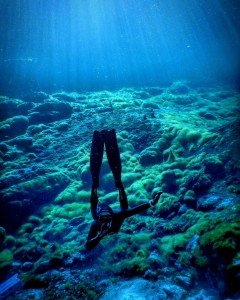The South East spans the coast from Kingston down to Nelson, just over the Victorian boarder, with over 200 km of coast line. There are many interesting dives lining this coast line from jetties to reefs and even some in land fresh water ponds.
Margaret Brock Reef
Rating: Novice
Max Depth: 12 m.
Margaret Brock Reef is a very pretty dive site, that most people dive for one reason alone: the gigantic crayfish that live in this area! The marine reserve stretches within .55 nautical miles of the lighthouse in any direction. The dive under the lighthouse is absolutely sensational! Within this area, there are ledges everywhere, with lots of gorgonians, sponges and such like, which make this a very interesting area. The occasional weedy and leafy sea dragon have been seen here as well.
Be careful when the swell is up. This can turn the water into a dishwasher in no time, so pick your time and day carefully. There is also “killer kelp” in abundance. These kelp trees grow to 20+ m. and can entangle you quite easily.
Robe
Stinky Bay
Rating: Novice
Max Depth: 8 m.
Stinky Bay is one of those spots where you will find new things every time you dive! The terrain is mostly made up of ledges and overhangs. Expect to see wobbegongs, crayfish, sea dragons and rays.
Beachport Jetty
Rating: Novice
Max Depth: 15 m.
Beachport has the second longest jetty in Australia (772 meters!), which creates a haven for all kinds of marine life. Watch out for fishing lines as there are always fishermen on the jetty!
Carpenter Rocks
Port MacDonnell
Ewens Ponds
Rating: Novice
Max Depth: 11 m.
Ewens Ponds is a dive site within the Ewens Ponds Conservation Park, which is world famous for its crystal clear waters.
It consists of three ponds that are connected by very shallow channels. Enter the first pond from the wooden platform close to the car park. Be cautious and use the ladder to get in, otherwise you are guaranteed to start your clearest dive ever, in a cloud of silt.
The water in these ponds has been filtered through the limestone for thousands and thousands of years, which makes these waters ‘the clearest in the world’, with visibility of up to 100 meters! It is also the only known home of the Ewens Pygmy Perch in the world.
The highlight of diving in the ponds is the visibility! It is not uncommon to be able to see from one side of the pond to the other, a distance of over 80 metres. The other highlight is the growth as you drift through the two channels – it is a fantastic experience. Ewens Ponds is a good location to have a model diver; having a diver in the photos gives an excellent perspective of how clear the water is. Some of the aquatic life in the ponds includes the spiny crayfish Euastacus bispinosis and the rare Ewen’s pygmy perch Nannoperca variegata and both can be very elusive to photograph.
The only real hazard is the temperature of the ponds. it is known to be only 10-15 degrees all year round, so its best dive on a sunny day that has some warmth for when you exit. Also remember to take some weight off the belt as the ponds are fresh water so you will find yourself to be less buoyant.
Be wary, at times, the site may be closed to diving for 3 months at a time as it has known to experience algal blooms and occasionally needs time to recuperate.
Contact the South Australian Department for Environment & Heritage in the Mt Gambier office Tel. (08) 8735 1111, if you are ever checking if the ponds are accessible.

